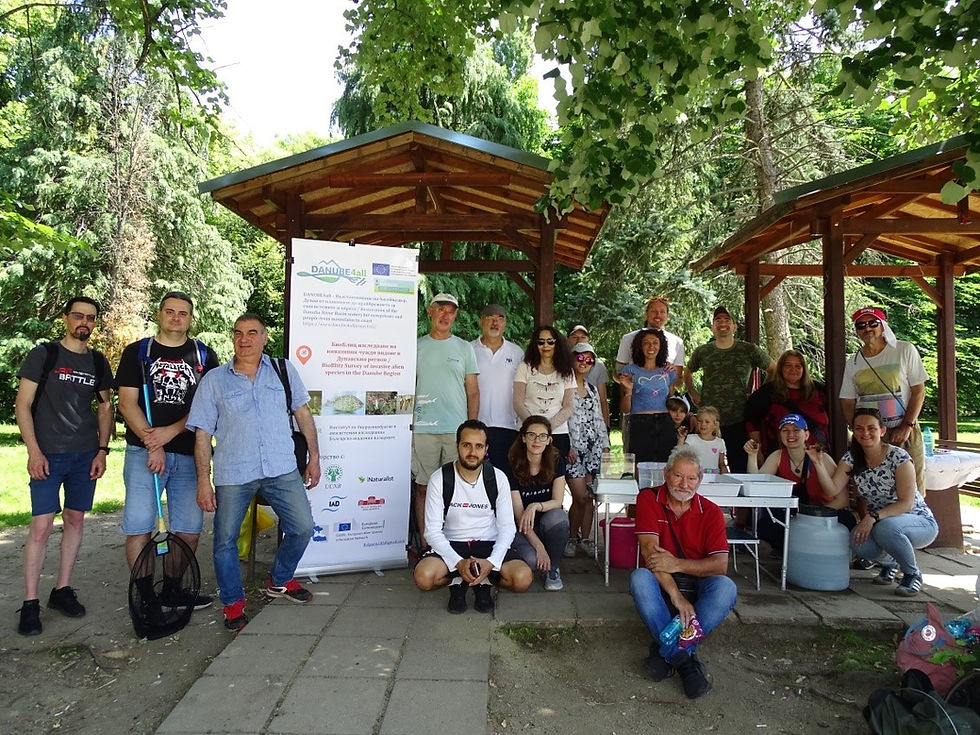Waters 2040: Experts discuss measures for a sustainable, resilient water management in the Danube region
- DANUBE4all

- Apr 12, 2024
- 5 min read
Updated: Jul 4, 2024
On Tuesday, April 9th, international experts from 21 nations gathered in the BOKU Riverlab to discuss the pressing problems of water management in the Danube catchment area due to climate change at the Waters 2040 Participation Day in Vienna, Austria.

Pictured (l-r) Helmut Habersack, Lead Project Coordinator DANUBE4all, Leonore Gewessler, Federal Minister for Climate Action, Environment, Energy, Mobility, Innovation and Technology (in the second Kurz government), and Stefan Lütgenau, Founding Director of Foster Europe. Photo courtesy of BOKU/Gruber.
As climate change progresses, droughts and floods will increase, potentially occurring simultaneously in the Danube region. This poses a risk of new conflicts over water in the heart of Europe. In her welcoming speech, Federal Minister for Climate Action, Environment, Energy, Mobility, Innovation and Technology, Leonore Gewessler, commented,
“The climate crisis is felt everywhere, including in our waters. Increasingly frequent, extreme weather events are endangering infrastructure and posing a serious risk to biodiversity. We can only meet these challenges through a joint effort by translating scientific findings into political practice. With the EU Danube Region Strategy we have a best practice example for this cooperation. Together, scenarios and concepts for a sustainable strategy are being developed for dealing with water and the water cycle - from the mountains to the Danube Delta. Protecting the Danube and its tributaries is a central task so that it continues to be a living space, water supply and transport route for Europe.”
A far-sighted, European water management strategy should balance conflicting interests and ensure a continuous water supply for people, the environment and the economy in the entire Danube region. More than 115 million people and numerous unique ecosystems depend on water management.
“The EU Danube Region Strategy has essential tasks of management and conflict avoidance in cooperation with the nation states and international organizations,” said Stefan Lütgenau from the Foster Europe Foundation, which, together with BOKU University and the students of its Doctoral School HR21, organised the Waters 2040 conference.“Directly affected interest groups, science and civil society must be involved in shaping future strategies.”
The impacts of climate change are already clearly felt, with altered annual and seasonal flows, including heavy rainfall events and droughts. “Users are and will be confronted with changing water quantities and water qualities,” explained Helmut Habersack, Head of the Institute of Hydraulic Engineering and River Research at BOKU University. “More frequent and severe flooding will affect livelihoods and infrastructure. Drought, exacerbated by glacier retreat, will impact agriculture, shipping and hydroelectric power generation. Tourism will be influenced by changing local hydrological conditions. Innovations through science and research contribute to developing nature-based solutions for sustainable water management that integrate the use and protection of rivers, lakes and groundwater.”
Photos courtesy of BOKU/Gruber
Waters 2024 Recommendations
A long-term transition towards sustainable development in the Danube River Basin is imperative. Society´s ability to adequately address present and future challenges in river management is required. The task requires cross-sectoral cooperation and involves securing water supply while safeguarding the Danube River Basin as a network of unique ecological systems.
The impact of climate change is evident, with altered annual and seasonal discharge, including heavy rain events and droughts. Users are already confronted with changed water quantity and quality. More frequent and higher floods will threaten livelihoods and infrastructure. Water shortages, intensified by the retreat of glaciers will affect agriculture, navigation and hydropower. A European far-sighted water management should balance conflicting interests and ensure a continuous water supply for people, the environment and the economy in the entire Danube region. The EUSDR has essential tasks of management and conflict avoidance in cooperation with the countries and international organizations.
New ways to reduce flood and drought risk have to be negotiated on local, regional, national and transnational levels. Directly concerned stakeholders, science and civil society must be involved in using co-creation and co-design approaches for developing future strategies.
Complementing the existing documents, the following specific recommendations have been identified for four main topics addressed in the Waters2040 Participation Day.
1. Extreme Hazards and Climate Change
1.1. Intensify integrated flood and drought risk management to improve the resilience of people and various water uses against extreme hazards increased by climate change
1.2. Review existing spatial planning regulations with respect to flood damage potential; improve and implement spatial planning regulations where these do not exist
1.3. Prioritize nature-based solutions (NbS) against pure technical measures, non-structural (adaption of usage) against structural flood protection, catchment measures against measures in the channel, retention measures against linear regulation measures
1.4. Improve water retention (e.g. by securing land), and groundwater recharge by river restoration to improve the situation during droughts
1.5. Protect and restore floodplains as Win-Win-Win measure to counteract biodiversity decline and reduce flood- and drought risk at the same time
1.6. Build blue-green infrastructures as climate change adaptation measures in urban environments
1.7. Close knowledge gaps, ensure access to data to different societal groups and communicate existing challenges and risks
2. Biodiversity Crisis & Challenges in Water Quality
2.1. Implement NbS in catchments and riverine landscapes with strategic spatial planning to retain water in the landscape, improve water quality and increase biodiversity
2.2. Provide the space for NbS and technical innovations within the whole river network to restore habitats and re-establish ecological connectivity, while considering barrier removal in tributaries as well
2.3. Reduce soil erosion and nutrient transport through best agricultural practices, including NbS
2.4. Make use of innovative monitoring approaches and in-situ observatories to develop targeted management measures for surface and groundwater systems. Harmonize the data collected and centralize it for sharing
2.5. Implement integrative and sustainable management plans and programs of measures, including pilot cases showing solutions for resilience and learning in the Danube River Basin
3. Energy and Transport
3.1. Implement measures and technologies (e.g., new hydropower types) to improve hydropower and ecology: reduce reservoir sedimentation, improve sediment continuity, reduce flood risk, increase safety, reduce impacts of residual flow or hydro-peaking
3.2. Establish new approaches to evaluate sustainable hydropower potential
3.3. Guarantee energy security in the context of wind energy and photovoltaics
3.4. Improve fairway conditions by joint navigation and ecological measures throughout the Danube network
3.5. Further develop the Danube waterway by using innovative groins, flexible infrastructure, river information services and river restoration where possible
3.6. Implement mitigation measures such as optimized ship types and wave-protecting structures to minimize negative effects of ship-induced waves on aquatic ecosystems
4. Co-creation, Co-design and Citizen Science
4.1. Develop Co-creation and Co-design methods, applicable to practical, cross-cutting use and decision-taking in extreme hazard reduction, biodiversity increase and sustainable hydropower and navigation
4.2. Apply Co-creation and Co-design methods at all larger projects in the Danube River Basin to increase awareness of the people, derive better solutions, reach acceptance and even a push to implement sustainable measures and river restoration
4.3. Create and provide Citizen Science tools to interested and affected people in the Danube Basin to collect data, create awareness, responsibility and stimulate engagement for minimising flood and drought risk, river restoration, sustainable hydropower and navigation
4.4. Establish a standard for Citizen Science application in practice, including technologies, such as virtual reality, apps, measurement instruments, digitalisation and databases
4.5. Link technical, natural and social sciences methods to improve the people´s participation capabilities and it´s success in projects
4.6. Foster cooperation and dialogue between stakeholders from hydropower, navigation, hazard management, agriculture and nature protection and restoration
Putting Waters 2040 into Action
In light of these recommendations, the EUSDR should intensify and expand the existing dialogue with the International Commission for the Protection of the Danube River, the Danube Commission and the Sava Commission on a transnational and multi-stakeholder level to develop an action framework and, subsequently, a catalogue of targeted actions considering all implementation levels and stakeholders. In the coming years, science, politics, administration, civil society and business should work in close cooperation with the river commissions and the EUSDR to develop concepts and win-win nature-based solutions in the form of a “Danube River Basin Restoration Action Plan” integrating use and protection (e.g. such as in the Horizon Europe Mission Project DANUBE4all).
The Waters2040 Participation Day organisers offer their good services to start a process of facilitation and consultation within the framework of the EUSDR and the relevant international bodies and treaties.













